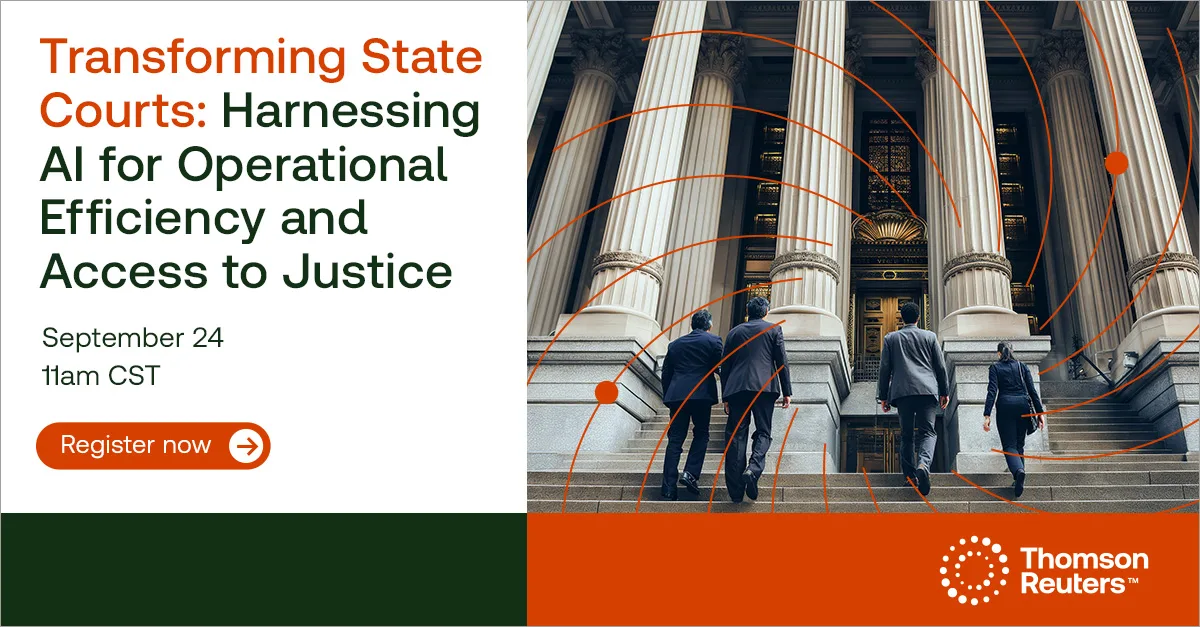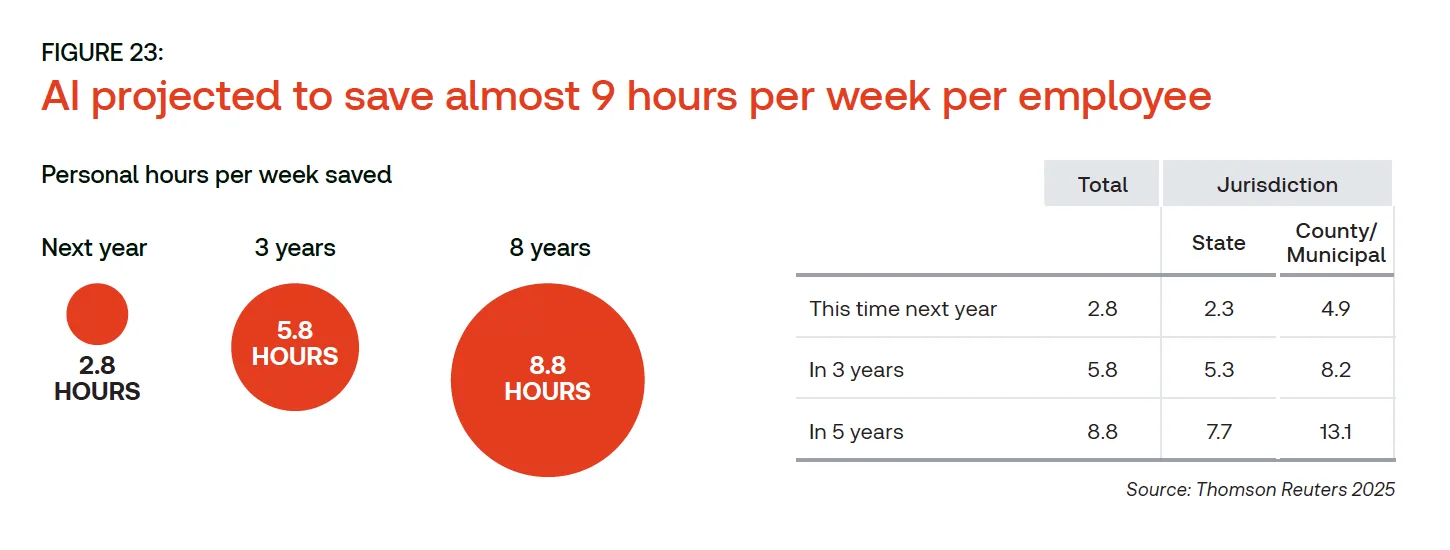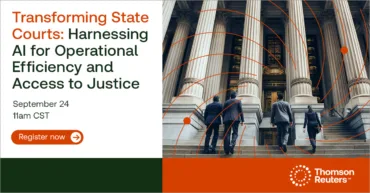If one thing can be said about those who work in our courts, they believe in and are proud of what they do. A second thing, just as true, is: challenges with budget and staffing constraints make that important work difficult.
As seen in Staffing, Operations and Technology: A 2025 survey of State Courts, efficiency remains a major issue for court professionals. Many are balancing their resources between current operations and investments in technology that could improve future operations, including the integration of generative AI (GenAI).

Webinar
Transforming state courts: Harnessing AI for operational efficiency and access to justice
Watch on-demand ↗Jump to ↓
| The shortcomings of the current courts |
| The impact of AI on court efficiency |
| Can AI ease courts’ staffing crunch? |
| Balancing efficiency of specific court operations |
The shortcomings of the current courts
The recent report by the Thomson Reuters Institute and the National Center for State Courts reveals that court staff are working longer hours, often exceeding 40 hours per week, without feeling productive or able to keep up with their workload. This has significant implications for staff well-being and court performance.
As cases become more complex due to new technology, courts must address technical gaps caused by the digital divide. Even though court staff work long hours, productivity is still a problem. Many courts cannot keep up with their workload, and staffing shortages make things worse. Recruiting new staff is difficult, especially as more employees retire at a higher rate.
Faced with these persistent challenges, courts are increasingly looking for innovative solutions to improve efficiency and reduce strain on staff. One promising avenue is the adoption of artificial intelligence (AI), which has the potential to address many of the operational hurdles currently impacting court systems.
The impact of AI on court efficiency
Courts, like the legal industry at large, often hesitate and take longer to adopt new technology and processes. And while most courts have adopted many key automated tools, they have generally been slower than the rest of the legal industry to adopt AI and GenAI.
Report responses indicate courts well understand GenAI’s enormous potential but are not yet making good use of it. 55% rated AI and GenAI as having a transformational or high impact on courts within the next five years.
Furthermore, respondents estimated that AI will save almost three hours per week within the next year and as many as nine hours per week within the next five years. Yet only 17% of respondents said they are using GenAI, and another 17% said they plan to adopt a GenAI solution within the next year.

A sensible first step for any court system that wants to make better use of AI would be to develop protocols or a policy on how to use these tools intelligently and effectively, and to then implement a program to train staff in how, when, and why to use the technology to its best effect.
Given GenAI’s transformational impact, courts are encouraged to evaluate available solutions and develop implementation plans — beginning with Thomson Reuters CoCounsel Legal, the industry’s professional-grade AI legal solution of choice. Courts across the U.S. federal court system — including the Supreme Court, circuit courts, and federal public defenders — as well as courts in 94% of U.S. states, have CoCounsel Legal.

CoCounsel Legal
Work smarter with CoCounsel, seamlessly integrated with Westlaw, Practical Law, Microsoft 365, and DMS partners
Go professional-grade AI ↗Can AI ease courts’ staffing crunch?
For many years, courts have struggled to attract and retain qualified staff. Those staffing woes are especially acute for clerk and non-legal staff roles, as Baby Boomer and Gen X workers retire from the workforce and Millennials move into management positions.
The report paints a stark picture: Most courts experienced a staff shortage over the past year, and that issue isn’t expected to be resolved any time soon. Consider this:
- Staffing challenges are of particular concern for state courts, with 71% predicting staff shortages will pose a problem in the next 12 months.
- When all courts are considered, the outlook isn’t much brighter: 61% percent of respondents said they expect to experience staff shortages.
- On top of that, nearly half (46%) of respondents feel shortages of skilled workers will have a transformational or high impact on courts over the next five years.
If the problems posed by staffing challenges deepen further, things don’t look good on the efficiency front. 77% of respondents said they encounter delays of 15 minutes or more for hearings in any given week, and 41% of those delays affect more than 10% of hearings.
AI can’t — and isn’t meant to — replace human professionals but AI-powered legal tools can increase those professionals’ efficiency and productivity. If court staffing challenges persist as is expected, the benefit of careful, thoughtful AI integration into court system workflows becomes apparent—and vital.
Additionally, organizations that are slow to adopt GenAI risk falling even further behind, whereas those that make strategic, effective use of it can thrive, improve, and do more with less.
Balancing efficiency of specific court operations
Enhancing efficiency is critical for court operations and can minimize the problems stemming from staffing issues. There is a strong correlation between the inefficiency of any given task and how prone it is to errors, meaning efficiency can improve accuracy and soundness, as well.
To increase efficiency as well as work product quality, courts should identify and target specific tasks for efficiency gains, reduction in errors, and preferably both. To measure true progress, courts need trackable metrics for both efficiency and accuracy, because focusing only on efficiency or throughput without considering errors may not yield the desired or meaningful court operations improvements.
Despite the struggles of workloads, staffing, backlogs, and delays, judges and court professionals remain hopeful about finding better ways to work moving forward. Ultimately, more efficient, technology-driven workflows could improve future operations for the nation’s courts, making them stronger in the coming years.

Staffing, Operations and Technology: A 2025 survey of State Courts
How judges and court professionals view the challenges to the judicial system
Access full report ↗












